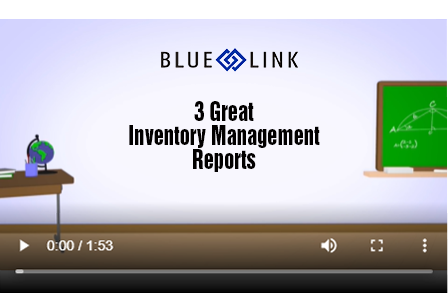As a company buying and selling products, your inventory management techniques are crucial to your business. You’ll need to be prepared for seasonality planning, potential returns, and replenishment. Demand forecasting with ERP software can be simple when reporting tools and warehouse/inventory management functionality is at your fingertips. Let’s explore what exactly demand forecasting is, how to handle inventory inconsistencies and then we’ll dive into a few ERP software reports to help you out.
What is Demand Forecasting?
Demand forecasting is the procedure of using historical data to predict and estimate future customer demands of your product. By analyzing the data, businesses can make smarter decisions for their supply chain, optimize inventory, and have a better overall view of the flow of goods. Demand forecasting is easier with ERP software as it will not only help with inventory planning but will also help you determine warehousing needs, staffing, budgeting, marketing and more.
Handling Inventory Inconsistencies
Your inventory is your business’s lifeline. If you hold inventory that doesn’t sell you lose out on valuable warehouse space and if you are not stocking up on high-volume products it results in lost sales and upset customers. Below we outline ways demand forecasting can help to handle potential inventory inconsistencies.
How to handle excess stock? Poor inventory management can lead to excess inventory in your warehouse that affects your bottom line when you inevitably have to sell it at a deep discount or liquidate items. It would be much more useful to use the storage space for stock that is fast-moving and more profitable. In order to avoid this, you can organize your warehouse’s corresponding bin and shelf locations based on inventory turnover. This will help to determine how quickly a product is sold and replaced and can help you make better decisions about pricing, purchasing, and more.
How to handle seasonality planning? Many items are purchased on a seasonal basis and for many businesses, it’s obvious when they will need to stock up on items. A drastic increase in demand for product is usually followed by a drastic decrease which can make inventory management a huge headache for business owners. Demand forecasting will give you insight into knowing when to purchase stock so you can avoid stocking inventory until you need it and optimize your warehouse space.
Seasonal planning is a good example of how demand forecasting can impact other areas of the business such as marketing and staffing. When you’re preparing for a busy season, you can plan to have more staff in your warehouse and spend your marketing dollars on the products that sell best all by using historical data.
How to handle replenishment? When replenishing stock, you must keep in mind all factors including on-hand quantities, products already committed to an order, and projected returns.
Let’s look at an example: The holiday season comes and goes quickly for most of us, especially businesses who see an influx of orders during this time. With so much product going out of the warehouse, you may be concerned that you don’t have enough for the next few months. So, because of the high influx of sales orders in December, you decide to add a few extra units to your next purchase order. January comes and your purchase order has arrived but you didn’t anticipate that 25% of your sales orders from December would be returned which means excess stock for January-February. Now what? What do you do with the excess stock and better yet, where do you put it? The best advice we can give you is to simply not let this happen and prepare in advance! Demand forecasting with ERP software avoids inventory inconsistencies and will help you take into account all factors before deciding what to add to your purchase order.
How Can ERP Help?
ERP software like Blue Link ERP has reporting functionality to help with demand forecasting to make better business decisions about inventory levels, what to purchase and what to get rid of. Here are three great inventory management reports to help you get started with demand forecasting.
Inventory Ranking Report – Ranks your products in descending order by gross margin over a period of time and compares the profitability of a product with the holding cost of that product. The report is useful because it will show you which products are occupying more space in your warehouse and more value on your balance sheet compared to their contribution to profits.
Inventory “Hits” Report – This report will show you how many times or “hits” a product appears on an invoice. This report is great when identifying products that appear infrequently but are a big part of your inventory.
Daily Average Sales Reports – These reports will show average daily sales over different periods of time (last month, last quarter, last year). It can help to uncover trends and identify where reorder levels and purchasing policies should be reviewed.











